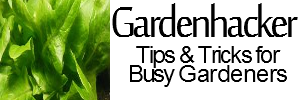Wicking beds are popular wherever it is dry or there are water restrictions, but that should not stop anyone in the northeast or northwest United States from trying one. Basically, you are making a small tray underneath your plants that hold water, similar to self-watering containers for your home. Soil will wick the water up to one foot, more than enough for this 2″ tray. By adding compostable materials like comfrey stalks, the added benefit is more nutrients for the plant. The one we are making here should last at least one season, and if the soil berms hold (not yet created due to all of the rain), could last up to several seasons.
We’re using a banana box here, since the double-corrugation holds up well. Additionally, we are using a sheet of plastic, a tube and some material gathered to sit in the “tray”, and some newspaper. These materials can be replaced with more permanent materials if you find you like the results.
Here are the steps:
 measure the bottom of your box and cut a piece of plastic that is four inches longer and wider. For us, our box was 15″x20″, so our plastic was cut to 19″x24″
measure the bottom of your box and cut a piece of plastic that is four inches longer and wider. For us, our box was 15″x20″, so our plastic was cut to 19″x24″- put the plastic into the box so there is two inches of plastic up the walls on all sides of the box.
 Add material into the “tray” – this can be gravel, hydroponic stone, or – since this is only temporary, you can add just about anything. Here we’ve added comfrey stalks – you can use weeds, wood chips, plastic tubing, etc.
Add material into the “tray” – this can be gravel, hydroponic stone, or – since this is only temporary, you can add just about anything. Here we’ve added comfrey stalks – you can use weeds, wood chips, plastic tubing, etc.- Add a plastic tube to the corner for watering and monitoring the water level.
 Add a “permeable layer – in this case newspaper to separate the soil from the water in the tray. If this was a permanent wicking bed, you would be using perforated plastic or garden fabric at this point.
Add a “permeable layer – in this case newspaper to separate the soil from the water in the tray. If this was a permanent wicking bed, you would be using perforated plastic or garden fabric at this point.- Add the soil and plant! We’ve used a layer of “square foot garden mix” that was left over from some other plantings, and a layer
 of composted soil.
of composted soil.









Recent Comments